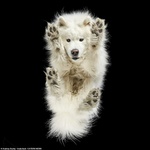Holistic Muscle & Joint Pain Relief - The 2016 Olympic Way = Cuping
5 posters
 Holistic Muscle & Joint Pain Relief - The 2016 Olympic Way = Cuping
Holistic Muscle & Joint Pain Relief - The 2016 Olympic Way = Cuping
What Are the Purple Dots on Michael Phelps? Cupping Has an Olympic Moment
By Gretchen Reynolds and Karen Crouse
August 8, 2016 8:24 am August 8, 2016 8:24 am
Swimmer Michael Phelps sported deep-purple circles on his shoulder and back when he won a gold medal on Sunday nightCredit Doug Mills/The New York Times
RIO DE JANEIRO — Olympics trivia: What has 19 gold medals and a bunch of purple circles?
If you watched a certain swimmer’s Rio Games debut on Sunday night, when he propelled the United States 4×100-meter relay team to a gold medal, you know the answer: Michael Phelps.
While it may look like Phelps and several other Olympians with those skin marks have been in a bar fight, the telltale dots actually are signs of “cupping,” an ancient Chinese healing practice that is experiencing an Olympic moment.
“Because this particular recovery modality shows blemishes on his skin, he walks around and looks like a Dalmatian or a really bad tattoo sleeve,” said Keenan Robinson, Phelps’s personal trainer. “It’s just another recovery modality. There’s nothing really particularly special about it.”
Practitioners of the healing technique — or sometimes the athletes themselves — place specialized cups on the skin. Then they use either heat or an air pump to create suction between the cup and the skin, pulling the skin slightly up and away from the underlying muscles.
The suction typically lasts for only a few minutes, but it’s enough time to cause the capillaries just beneath the surface to rupture, creating the circular, eye-catching bruises that have been so visible on Phelps as well as members of the United States men’s gymnastics team. If the bruising effect looks oddly familiar, it’s because it’s the same thing that happens when someone sucks on your neck and leaves a hickey.
“I’ve done it before meets, pretty much every meet I go to,” Phelps said on Monday. “So I asked for a little cupping yesterday because I was sore and the trainer hit me pretty hard and left a couple of bruises.”
Pysiologically, cupping is thought to draw blood to the affected area, reducing soreness and speeding healing of overworked muscles. Athletes who use it swear by it, saying it keeps them injury free and speeds recovery. Phelps, whose shoulders were dotted with the purple marks as he powered the relay team, featured a cupping treatment in a recent video for a sponsor. He also posted an Instagram photo showing himself stretched on a table as his Olympic swimming teammate Allison Schmitt placed several pressurized cups along the back of his thighs. “Thanks for my cupping today!” he wrote.
“There is a psychological component where Michael has been doing this to feel good for a long time, about two years,” Mr. Robinson said. “Anything you can do to get the body to feel good — you have to use an educational assessment on it. You have to make sure that what you’re doing is causing a physiological intent to recover.
“I’m not just going to throw a stick of butter on him,” Robinson said, adding, “I’m going to make sure I have an educated approach to it.”
While there’s no question that many athletes, coaches and trainers believe in the treatment, there’s not much science to determine whether cupping offers a real physiological benefit or whether the athletes simply are enjoying a placebo effect.
One 2012 study of 61 people with chronic neck pain compared cupping to a technique called progressive muscle relaxation, or P.M.R., during which a patient deliberately tenses his muscles and then focuses on relaxing them. Half the patients used cupping while the other half used P.M.R. Both patient groups reported similar reductions in pain after 12 weeks of treatment. Notably, the patients who had used cupping scored higher on measurements of well-being and felt less pain when pressure was applied to the area. Even so, the researchers noted that more study is needed to determine the potential benefits of cupping.
Another experiment involving 40 patients who suffered from knee arthritis found that people who underwent cupping reported less pain after four months compared to arthritis sufferers in a control group who were not treated. But the cupped group knew they were being treated — it’s not easy to blind people about whether a suction cup is being attached to their leg or not — and so the benefits might have been due primarily to a placebo effect.
Lithuanian swimmer Ruta Meilutyte had the telltale signs of cupping when she raced on Sunday night.Credit Doug Mills/The New York Times
Still, a placebo effect can be beneficial, and for athletes at the Olympic level any legal edge, however tenuous, may be worth a few eye-catching bruises.
“A placebo effect is present in all treatments, and I am sure that it is substantial in the case of cupping as well,” said Leonid Kalichman, a senior lecturer at Ben-Gurion University of the Negev in Israel, who recently co-authored a commentary reviewing cupping research in the Journal of Bodywork and Movement Therapies. “A patient can feel the treatment and has marks after it, and this can contribute to a placebo effect.”
Even so, Dr. Kalichman said he believes the treatment has a real physiological effect as well. It may be that cupping, by causing local inflammation, triggers the immune system to produce cytokines, small proteins that enhance communication between cells and help to modulate the immune response.
A few years ago the Denver Broncos player DeMarcus Ware posted a photo on Instagram showing his back covered with 19 clear cups as a therapist held a flame used to heat the cup before placing it on the skin. Celebrities including Jennifer Aniston and Gwyneth Paltrow have also been photographed with cupping marks on their skin.
Last year, Swimming World magazine noted that some college programs had begun using cupping therapy as well as the former Olympian Natalie Coughlin, who has posted a number of photos of herself undergoing the treatment.
“We know that science says it isn’t detrimental,” Mr. Robinson said. “We know that science says it does in some cases help out. So we’re at least going to expose the athletes to it years out so they can at least get a routine into it.”
Todd Schmitz, who coaches the Olympic swimmer Missy Franklin, said Franklin started using cupping when she joined the swim team at Cal-Berkeley. “I would say cupping is very much along the lines of ice baths,” Schmitz said. “Some people will tell you that ice baths have no purpose whatsoever. It’s one of those things if you think it helps you, you leave it in your repertoire.”
The American gymnast Alexander Naddour was sporting the purple dots during the men’s qualifying rounds on Saturday in Rio. He told USA Today that he bought a do-it-yourself cupping kit from Amazon. “That’s been the secret that I have had through this year that keeps me healthy,” Naddour told USA Today. “It’s been better than any money I’ve spent on anything else.”
Kevin Rindal, the chiropractor for the United States swim teams, is one of only four chiropractors Phelps trusts to work on him. Rindal said that the device they use can be found on Amazon for $30. He acknowledged that some practitioners might not use it effectively.
“I had a patient come in and he had a headache and he had a huge cup on his forehead because he thought he could cup his forehead,” Rindal said. “So people do some ridiculous stuff.”
http://well.blogs.nytimes.com/2016/08/08/what-are-the-purple-dots-on-michael-phelps-cupping-has-an-olympic-moment/?_r=0
Trying anything besides Opioids for muscle & joint pain - especially for performing athletes ...always the best way to go!
Guest- Guest
 Re: Holistic Muscle & Joint Pain Relief - The 2016 Olympic Way = Cuping
Re: Holistic Muscle & Joint Pain Relief - The 2016 Olympic Way = Cuping
Bruises can be dangerous, though ...
 Re: Holistic Muscle & Joint Pain Relief - The 2016 Olympic Way = Cuping
Re: Holistic Muscle & Joint Pain Relief - The 2016 Olympic Way = Cuping
Certainly, if they're deep muscle type of bruises ...possibility of the body forming blood clots; but his were on his shoulder blades.Ben Reilly wrote:Bruises can be dangerous, though ...
Guest- Guest
 Re: Holistic Muscle & Joint Pain Relief - The 2016 Olympic Way = Cuping
Re: Holistic Muscle & Joint Pain Relief - The 2016 Olympic Way = Cuping
The idea of cupping in theory is to encourage blood flow and removal of stale blood and lymph. I have to say, my ex suffered the most awful acne on his back, and was always smothered in eruptions. On a holiday to Turkey, he had some dry cupping, and within days the part of his back where the cupping took place was completely clear of acne for months. I'd never seen anything before or since that was so effective.
Massage does the same thing basically - encourages fresh blood through muscles and tissue.
Massage does the same thing basically - encourages fresh blood through muscles and tissue.

HoratioTarr- Forum Detective ????♀️
- Posts : 10037
Join date : 2014-01-12
 Re: Holistic Muscle & Joint Pain Relief - The 2016 Olympic Way = Cuping
Re: Holistic Muscle & Joint Pain Relief - The 2016 Olympic Way = Cuping
Ben Reilly wrote:Bruises can be dangerous, though ...
It's more like a love bite type bruise, rather than a heavy damaging bruise. There's a practice called Muscle Detox Therapy where the muscles are hit with bamboo sticks. The theory is it releases and breaks down toxins from the muscles and alleviates muscular pain including frozen shoulder, and helps the body to heal faster. I have to say, I tried it once on myself when I had terrible low back strain...I was black and blue after I'd done, but the pain was gone!

HoratioTarr- Forum Detective ????♀️
- Posts : 10037
Join date : 2014-01-12

HoratioTarr- Forum Detective ????♀️
- Posts : 10037
Join date : 2014-01-12
 Re: Holistic Muscle & Joint Pain Relief - The 2016 Olympic Way = Cuping
Re: Holistic Muscle & Joint Pain Relief - The 2016 Olympic Way = Cuping
"Cupping" isn't particularly new...
Massage therapists, chiropractors, a few physio's and osteopaths have known about it for decades.. Which makes it more of "traditional modality" rather than an alternative therapy -- in the same class as Shiatsu, Reiki, deep muscle massage, kinesiology, Alexander technique -- they all have their place in helping with recovery and recuperation.
As it says in the OP (my paraphrasing here..), it's simply another weapon in the remedial therapists arsenal to help in muscle and joint recovery..

'Wolfie- Forum Detective ????♀️
- Posts : 8189
Join date : 2016-02-24
Age : 66
Location : Lake Macquarie, NSW, Australia
 Re: Holistic Muscle & Joint Pain Relief - The 2016 Olympic Way = Cuping
Re: Holistic Muscle & Joint Pain Relief - The 2016 Olympic Way = Cuping
4EVER2 wrote:What Are the Purple Dots on Michael Phelps? Cupping Has an Olympic Moment
By Gretchen Reynolds and Karen Crouse
August 8, 2016 8:24 am August 8, 2016 8:24 am
Swimmer Michael Phelps sported deep-purple circles on his shoulder and back when he won a gold medal on Sunday nightCredit Doug Mills/The New York Times
RIO DE JANEIRO — Olympics trivia: What has 19 gold medals and a bunch of purple circles?
If you watched a certain swimmer’s Rio Games debut on Sunday night, when he propelled the United States 4×100-meter relay team to a gold medal, you know the answer: Michael Phelps.
While it may look like Phelps and several other Olympians with those skin marks have been in a bar fight, the telltale dots actually are signs of “cupping,” an ancient Chinese healing practice that is experiencing an Olympic moment.
“Because this particular recovery modality shows blemishes on his skin, he walks around and looks like a Dalmatian or a really bad tattoo sleeve,” said Keenan Robinson, Phelps’s personal trainer. “It’s just another recovery modality. There’s nothing really particularly special about it.”
Practitioners of the healing technique — or sometimes the athletes themselves — place specialized cups on the skin. Then they use either heat or an air pump to create suction between the cup and the skin, pulling the skin slightly up and away from the underlying muscles.
The suction typically lasts for only a few minutes, but it’s enough time to cause the capillaries just beneath the surface to rupture, creating the circular, eye-catching bruises that have been so visible on Phelps as well as members of the United States men’s gymnastics team. If the bruising effect looks oddly familiar, it’s because it’s the same thing that happens when someone sucks on your neck and leaves a hickey.
“I’ve done it before meets, pretty much every meet I go to,” Phelps said on Monday. “So I asked for a little cupping yesterday because I was sore and the trainer hit me pretty hard and left a couple of bruises.”
Pysiologically, cupping is thought to draw blood to the affected area, reducing soreness and speeding healing of overworked muscles. Athletes who use it swear by it, saying it keeps them injury free and speeds recovery. Phelps, whose shoulders were dotted with the purple marks as he powered the relay team, featured a cupping treatment in a recent video for a sponsor. He also posted an Instagram photo showing himself stretched on a table as his Olympic swimming teammate Allison Schmitt placed several pressurized cups along the back of his thighs. “Thanks for my cupping today!” he wrote.
“There is a psychological component where Michael has been doing this to feel good for a long time, about two years,” Mr. Robinson said. “Anything you can do to get the body to feel good — you have to use an educational assessment on it. You have to make sure that what you’re doing is causing a physiological intent to recover.
“I’m not just going to throw a stick of butter on him,” Robinson said, adding, “I’m going to make sure I have an educated approach to it.”
While there’s no question that many athletes, coaches and trainers believe in the treatment, there’s not much science to determine whether cupping offers a real physiological benefit or whether the athletes simply are enjoying a placebo effect.
One 2012 study of 61 people with chronic neck pain compared cupping to a technique called progressive muscle relaxation, or P.M.R., during which a patient deliberately tenses his muscles and then focuses on relaxing them. Half the patients used cupping while the other half used P.M.R. Both patient groups reported similar reductions in pain after 12 weeks of treatment. Notably, the patients who had used cupping scored higher on measurements of well-being and felt less pain when pressure was applied to the area. Even so, the researchers noted that more study is needed to determine the potential benefits of cupping.
Another experiment involving 40 patients who suffered from knee arthritis found that people who underwent cupping reported less pain after four months compared to arthritis sufferers in a control group who were not treated. But the cupped group knew they were being treated — it’s not easy to blind people about whether a suction cup is being attached to their leg or not — and so the benefits might have been due primarily to a placebo effect.
Lithuanian swimmer Ruta Meilutyte had the telltale signs of cupping when she raced on Sunday night.Credit Doug Mills/The New York Times
Still, a placebo effect can be beneficial, and for athletes at the Olympic level any legal edge, however tenuous, may be worth a few eye-catching bruises.
“A placebo effect is present in all treatments, and I am sure that it is substantial in the case of cupping as well,” said Leonid Kalichman, a senior lecturer at Ben-Gurion University of the Negev in Israel, who recently co-authored a commentary reviewing cupping research in the Journal of Bodywork and Movement Therapies. “A patient can feel the treatment and has marks after it, and this can contribute to a placebo effect.”
Even so, Dr. Kalichman said he believes the treatment has a real physiological effect as well. It may be that cupping, by causing local inflammation, triggers the immune system to produce cytokines, small proteins that enhance communication between cells and help to modulate the immune response.
A few years ago the Denver Broncos player DeMarcus Ware posted a photo on Instagram showing his back covered with 19 clear cups as a therapist held a flame used to heat the cup before placing it on the skin. Celebrities including Jennifer Aniston and Gwyneth Paltrow have also been photographed with cupping marks on their skin.
Last year, Swimming World magazine noted that some college programs had begun using cupping therapy as well as the former Olympian Natalie Coughlin, who has posted a number of photos of herself undergoing the treatment.
“We know that science says it isn’t detrimental,” Mr. Robinson said. “We know that science says it does in some cases help out. So we’re at least going to expose the athletes to it years out so they can at least get a routine into it.”
Todd Schmitz, who coaches the Olympic swimmer Missy Franklin, said Franklin started using cupping when she joined the swim team at Cal-Berkeley. “I would say cupping is very much along the lines of ice baths,” Schmitz said. “Some people will tell you that ice baths have no purpose whatsoever. It’s one of those things if you think it helps you, you leave it in your repertoire.”
The American gymnast Alexander Naddour was sporting the purple dots during the men’s qualifying rounds on Saturday in Rio. He told USA Today that he bought a do-it-yourself cupping kit from Amazon. “That’s been the secret that I have had through this year that keeps me healthy,” Naddour told USA Today. “It’s been better than any money I’ve spent on anything else.”
Kevin Rindal, the chiropractor for the United States swim teams, is one of only four chiropractors Phelps trusts to work on him. Rindal said that the device they use can be found on Amazon for $30. He acknowledged that some practitioners might not use it effectively.
“I had a patient come in and he had a headache and he had a huge cup on his forehead because he thought he could cup his forehead,” Rindal said. “So people do some ridiculous stuff.”
http://well.blogs.nytimes.com/2016/08/08/what-are-the-purple-dots-on-michael-phelps-cupping-has-an-olympic-moment/?_r=0
Trying anything besides Opioids for muscle & joint pain - especially for performing athletes ...always the best way to go!
It makes me think about wallpapers, I hope the therapists can come up with some funky patterns that are worth nicking!!


JulesV- Forum Detective ????♀️
- Posts : 4275
Join date : 2016-07-30
Location : Vantage Point
 Re: Holistic Muscle & Joint Pain Relief - The 2016 Olympic Way = Cuping
Re: Holistic Muscle & Joint Pain Relief - The 2016 Olympic Way = Cuping
I had cupping done for about 2 years until my practitioner moved away. It helped much better than deep tissue/sports massage. Every time I slept like the dead after a treatment. I really benefited from it from muscles, sleep to migraines.
Now I am trying out Gua sha, but I still am hoping someone new moves in.
Now I am trying out Gua sha, but I still am hoping someone new moves in.

Cass- the Nerd Queen of Nerds, the Lover of Books who Cooks
- Posts : 6617
Join date : 2014-01-19
Age : 56
 Re: Holistic Muscle & Joint Pain Relief - The 2016 Olympic Way = Cuping
Re: Holistic Muscle & Joint Pain Relief - The 2016 Olympic Way = Cuping
Cass wrote:I had cupping done for about 2 years until my practitioner moved away. It helped much better than deep tissue/sports massage. Every time I slept like the dead after a treatment. I really benefited from it from muscles, sleep to migraines.
Now I am trying out Gua sha, but I still am hoping someone new moves in.
Truth to all that; I've had both and deep muscle massage just can't keep the pressure on as the suction application does for sore muscles and to move the blood flow to that area if there's been tendon problems/torn ligaments from previous issues in the past - best dang treatment EVER.
Guest- Guest
 Similar topics
Similar topics» Rio 2016 Media Bus Attacked On Day Four Of Olympic Games
» Rio 2016: Olympic athlete Isadora Cerullo gets engaged to girlfriend on rugby field
» Body Parts Washing Up On The Beach - Impeaching Their President - Zero Money To Pay The Police & EMT's; What Else Can Go Wrong At the 2016 Olympic's In RIO?
» Inevitable muscle wasting of old age could be stopped, scientists believe
» A bear walks into a barbecue joint
» Rio 2016: Olympic athlete Isadora Cerullo gets engaged to girlfriend on rugby field
» Body Parts Washing Up On The Beach - Impeaching Their President - Zero Money To Pay The Police & EMT's; What Else Can Go Wrong At the 2016 Olympic's In RIO?
» Inevitable muscle wasting of old age could be stopped, scientists believe
» A bear walks into a barbecue joint
Permissions in this forum:
You cannot reply to topics in this forum


» TOTAL MADNESS Great British Railway Journeys among shows flagged by counter terror scheme ‘for encouraging far-right sympathies
» Interesting COVID figures
» HAPPY CHRISTMAS.
» The Fight Over Climate Change is Over (The Greenies Won!)
» Trump supporter murders wife, kills family dog, shoots daughter
» Quill
» Algerian Woman under investigation for torture and murder of French girl, 12, whose body was found in plastic case in Paris
» Wind turbines cool down the Earth (edited with better video link)
» Saying goodbye to our Queen.
» PHEW.
» And here's some more enrichment...
» John F Kennedy Assassination
» Where is everyone lately...?
» London violence over the weekend...
» Why should anyone believe anything that Mo Farah says...!?
» Liverpool Labour defends mayor role poll after turnout was only 3% and they say they will push ahead with the option that was least preferred!!!
» Labour leader Keir Stammer can't answer the simple question of whether a woman has a penis or not...
» More evidence of remoaners still trying to overturn Brexit... and this is a conservative MP who should be drummed out of the party and out of parliament!
» R Kelly 30 years, Ghislaine Maxwell 20 years... but here in UK...